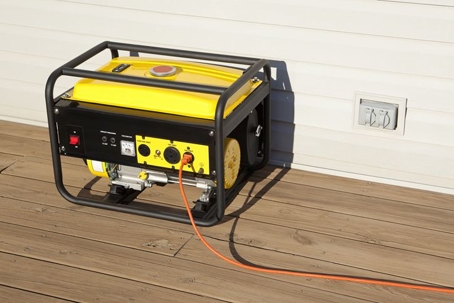When an emergency occurs, it pays to be prepared. Whether your area suffers from the occasional blackout due to storms or traffic accidents, having a generator on hand can keep your home or business up and running with the essentials until the power is back. A portable generator works by turning an onboard alternator into electricity that is then used to power your home. It has a gas engine and outlets which you can connect extensions to power many items.
At Knee’s Electrical Services, our licensed electricians have installed thousands of standby and portable generators, and understand the ins and outs of these units, as well as which one will meet your needs best. Today, we’re sharing the parts of a portable generator and if it may be right for you. Home generators work by closely monitoring your home's voltage supply. Whenever it picks up on a problem, it will automatically turn on to ensure no lost power
Parts of a Portable Generator
Much like an electrical plant, only in miniature, a portable generator works by converting mechanical energy into electrical energy. Many models use gas as a cheap and convenient way to get this process started, but you can also find diesel or propane units.
Five primary components of a portable generator:
- Internal combustion engine: The workhorse of the generator. Fuel is injected into this chamber, where a spark is created, converting the fuel into mechanical energy.
- Alternator: This is where the ‘magic’ happens. The alternator uses two parts to convert the mechanical energy into electricity. A rotating component – often called the rotator – creates a magnetic field around a group of wound coils, which generates an excess of electrons.
- Starter: Simply put, the starter starts your generator. Sometimes the starter is powered by a DC battery, and other times, it is a pull cord mechanism.
- Fuel tank: Typically, portable generators are fueled using gas, diesel, or propane. This makes them accessible to initially fuel, but keep in mind, these fuel sources don’t last forever, and much like a lawnmower that doesn’t turn on if it’s been sitting in the garage for too long, running your generator a couple of times a year will go a long way in ensuring your fuel is still ready when you need it.
- Outlets: The number and configuration of outlets is dependent on the make and model of your portable generator. Often, the more expensive your generator is, the more combinations of outlet types you’ll have.
How do Electrical Generators Work?
Very similar to "how do electrical generators work?" is "how does a generator produce electricity?". They produce electricity by converting mechanical or chemical energy into electrical energy. By forcing electrons from an external source through an electrical circuit, they convert the power of motion into electrical energy. A generator is basically an electric motor working in reverse.
Is a Portable Generator Right for You?
Portable generators are a convenient and cost-effective energy solution, but they might not be for everyone. Our technicians at Knee’s Electrical Services professionally install both standby and portable generators, and we can help you decide what type of generator is right for you and your home.
We understand budget is a huge deciding factor when it comes to purchasing a generator, and you can find a portable unit for under $2,000. In fact, there are many 3kW options for only $500. There is also no installation costs associated with a portable generator. However, what you save in cost you pay for in manual labor and limited power.
Unlike standby generators, which start automatically the second the power goes out, portable units need to be started manually and refueled often. Additionally, you need to be thoughtful about the types of appliances plugged into a portable generator. Because you will need to manually run an extension cord to your portable system which has a limited configuration of outlets, you need to consider the watts needed to power your needed appliances. Portable generators can also be dangerous if left indoors.
These systems produce carbon monoxide and if not ventilated properly can have harmful effects. Make sure to run the generator outside and obtain a tent if you are not confident the system will run well in inclement weather like rain. To learn more about generator options for you and your home, call our experienced team at Knee’s Electrical Services today. We will happily advise you on a unit that fits your budget and energy needs.
To learn more about generator installation or how our team can help you, call us at (765) 201-7220 or contact us online.

